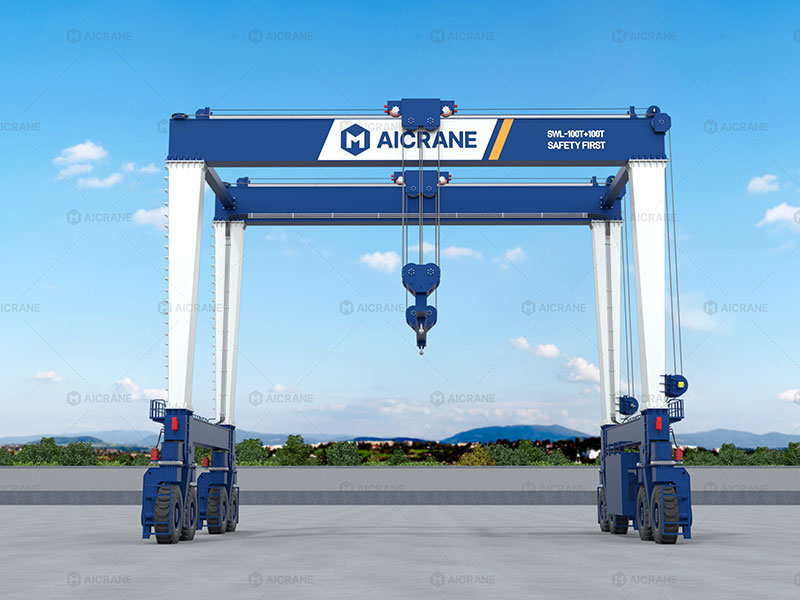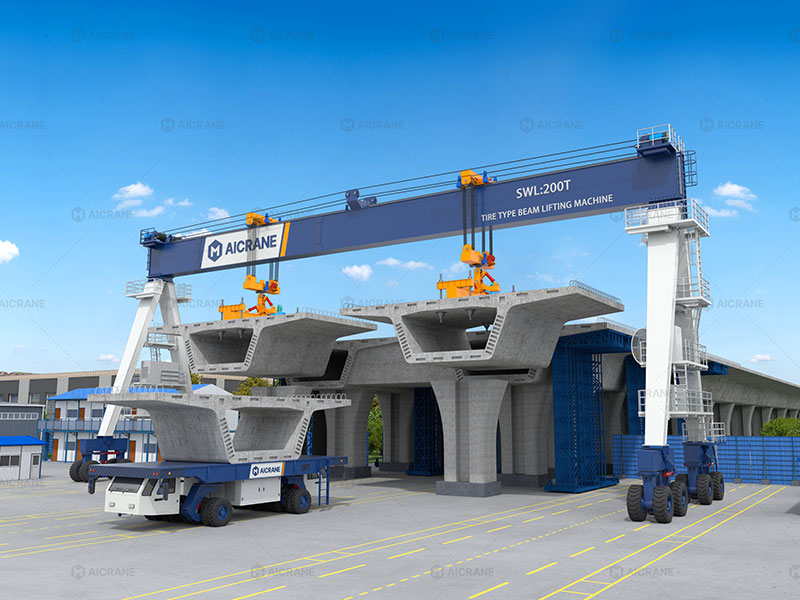Modern mobile gantry cranes have become indispensable in industries such as shipbuilding, precast concrete production, steel fabrication, and logistics. Among the numerous technological advancements that enhance their performance, hydraulic steering systems stand out as a crucial innovation that greatly improves maneuverability, precision, and safety – especially for large-capacity gantry cranes operating in complex environments.
This article explores what hydraulic steering systems are, how they work, and the major benefits they bring to large mobile gantry cranes.

Understanding Hydraulic Steering Systems in Gantry Cranes
A hydraulic steering system uses pressurized hydraulic fluid to transmit force from the operator’s control unit to the crane’s steering actuators or cylinders. These cylinders control the direction of the crane’s wheels, allowing precise turning angles even under heavy loads.
Unlike mechanical or electric steering, which may require significant effort or lack fine control, hydraulic steering delivers power-assisted movement, enabling operators to smoothly steer multi-wheeled gantry cranes of large capacity and size.
Hydraulic steering is especially vital in rubber tyred gantry (RTG) cranes and mobile gantry cranes used in outdoor yards, ports, or construction sites, where the crane must move efficiently through tight spaces and uneven terrain.
Key Components of a Hydraulic Steering System
A typical hydraulic steering system in a large mobile gantry crane includes the following main components:
-
Hydraulic Pump: Generates the necessary hydraulic pressure to operate the steering cylinders.
-
Steering Valves: Control the flow direction and pressure of hydraulic fluid to the steering cylinders.
-
Hydraulic Cylinders: Convert the hydraulic pressure into mechanical movement to turn the wheels.
-
Reservoir: Stores the hydraulic fluid used in the system.
-
Sensors and Control Units: Monitor wheel positions, load angles, and steering responses to ensure synchronized movement.
This system design allows for flexible and accurate control over each wheel group, which is essential for large wheeled gantry cranes that often have four, eight, or more steering wheels.

1. Enhanced Maneuverability and Flexibility
One of the greatest advantages of a hydraulic steering system is the superior maneuverability it offers. Large mobile gantry cranes, due to their weight and dimensions, require a powerful and flexible system to move smoothly in confined spaces.
Hydraulic steering allows multiple steering modes, including:
-
Straight Steering: For linear travel over long distances.
-
Crab Steering: All wheels turn in the same direction, enabling diagonal movement.
-
Transverse Steering: The crane moves sideways – perfect for limited spaces.
-
Pivot Steering: Allows the crane to rotate around its center axis for quick direction changes.
These modes make hydraulic steering systems indispensable for operations in precast concrete yards, shipyards, and large construction sites, where space optimization and precise alignment are essential.
2. Smooth and Precise Operation
Hydraulic systems are known for their ability to provide smooth and proportional control. Operators can make minute adjustments to the steering angle without sudden jerks or delays.
This precision is particularly beneficial when handling long concrete beams, large boat hulls, or heavy machinery components, where even small misalignments can lead to safety risks or damage.
Moreover, the smooth control minimizes tire wear and reduces mechanical stress on the RTG gantry crane structure, extending the service life of the entire equipment.
3. High Power Output with Minimal Effort
Steering a massive mobile gantry crane manually would require enormous effort. Hydraulic steering systems amplify operator input using pressurized fluid, which transmits force efficiently with minimal loss.
This power assistance allows even a single operator to handle large cranes smoothly, regardless of load weight. It also ensures consistent steering performance under all load conditions – whether the crane is fully loaded or unloaded.
The ability to generate high torque effortlessly makes hydraulic steering particularly advantageous for heavy duty gantry cranes above 100 tons capacity, ensuring reliable control in all working environments.
4. Stability and Safety in Operation
Safety is always a top priority in crane operation. Hydraulic steering systems contribute significantly to operational safety through:
-
Stable Response: Smooth, controlled steering minimizes risks of sudden movement that could destabilize a heavy load.
-
Pressure Regulation: Built-in relief valves prevent over-pressurization and potential system damage.
-
Fail-Safe Mechanisms: In case of hydraulic pump failure, the system can hold the steering position, preventing uncontrolled movement.
-
Improved Ground Contact: Hydraulic control ensures equal wheel load distribution, maintaining balance on uneven surfaces.
These safety benefits make hydraulic steering a preferred choice for cranes working in challenging outdoor or coastal environments, where ground conditions can vary.
5. Compact and Space-Efficient Design
Compared to complex mechanical linkages, hydraulic steering systems use flexible hoses and compact cylinders, which save space and reduce overall system weight.
This compact design not only simplifies installation and maintenance but also allows manufacturers to create modular mobile gantry cranes that are easier to transport and assemble.
Additionally, the absence of long mechanical steering rods reduces vibration and noise, improving the overall working environment.
6. Reduced Maintenance and Longer Lifespan
While hydraulic systems require periodic fluid checks, they are generally more durable and less prone to wear than mechanical systems with numerous moving parts.
The self-lubricating nature of hydraulic oil reduces friction, while sealed components protect the system from dust and debris — a crucial advantage in outdoor crane applications.
With proper maintenance, hydraulic steering systems can operate reliably for many years, lowering the total cost of ownership and minimizing downtime.
7. Compatibility with Automation and Smart Controls
Modern hydraulic steering systems can be integrated with electronic control units (ECUs) and sensors to create semi-automatic or fully automated steering solutions.
These systems can automatically adjust wheel positions based on crane movement, load distribution, or preset steering patterns. When connected with GPS and IoT systems, operators can even monitor and control steering remotely, improving operational efficiency and reducing human error.
This integration aligns perfectly with the growing trend toward intelligent and digitalized lifting equipment, making hydraulic steering a future-proof investment.
8. Adaptability to Various Terrain Conditions
Large mobile gantry cranes often operate in outdoor yards, where surfaces may be rough, inclined, or uneven. Hydraulic steering systems provide adaptive control, allowing smooth motion even when the terrain changes.
By regulating pressure to individual steering cylinders, the system maintains balance and stability, reducing the risk of tire slippage or frame distortion. This adaptability ensures safe and efficient operation across different working environments — from concrete yards to dockside areas.
Conclusion
The integration of hydraulic steering systems in large mobile gantry cranes marks a significant advancement in crane mobility and performance. By combining powerful torque, precise control, and flexible steering modes, these systems enable operators to handle heavy loads with ease, safety, and efficiency.
From improved maneuverability and reduced operator fatigue to enhanced safety and long-term reliability, the benefits of hydraulic steering systems make them an essential feature for modern large mobile gantry cranes used across various industries.
As industrial lifting requirements continue to evolve, hydraulic steering will remain a cornerstone technology — enabling cranes to operate smarter, safer, and more efficiently in demanding work environments.